By O. F. Snelling[It is a pleasure to reproduce this piece – penned by the late, great boxing writer O. F. Snelling – for a new, online, 21st-century audience. We do so with the kind permission of Derek O’Dell, Editor and Producer of ‘The Southern Ex-Boxer’, in which this article first appeared in 1998 – Ed.] |
(Jack Hood) |
Although this periodical is entitled
The Southern Ex-Boxer, and we tend to celebrate the deeds of those battlers of the past who hailed from ‘south of Watford’, as they say – and in particular the sterling scrappers of the South London and Croydon areas – the names and deeds of a few fighters from other areas do occasionally creep in.
It has been known for us to make mention of pugilists like Jack Hood, of Birmingham – one of the very best – and we've also dwelt upon those characters beloved by Geordieland's
Ringwise. Oh boy, what a bunch
they had, on Tyneside! Seaman Tommy Watson, Mickey Maguire, Benny Sharkey, Jack Casey, Jack London – and the great Billy Charlton, among others.
Most of these men were of
world class! I kid you not! But, unfortunately, they dwelt in unsophisticated surroundings, and their managers, although capable enough, did not always carry the influence to negotiate their men into prestigious fights, and they lost out – with one or two notable exceptions.
 Although our website boxinghistory.org.uk has not been formally launched, web pages are being constructed and plenty of information is already available to anyone interested in the history of boxing in Britain.
Although our website boxinghistory.org.uk has not been formally launched, web pages are being constructed and plenty of information is already available to anyone interested in the history of boxing in Britain.















